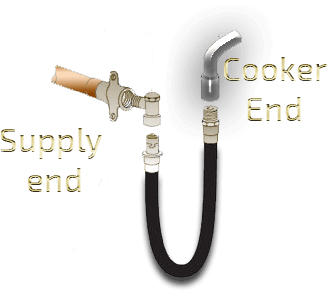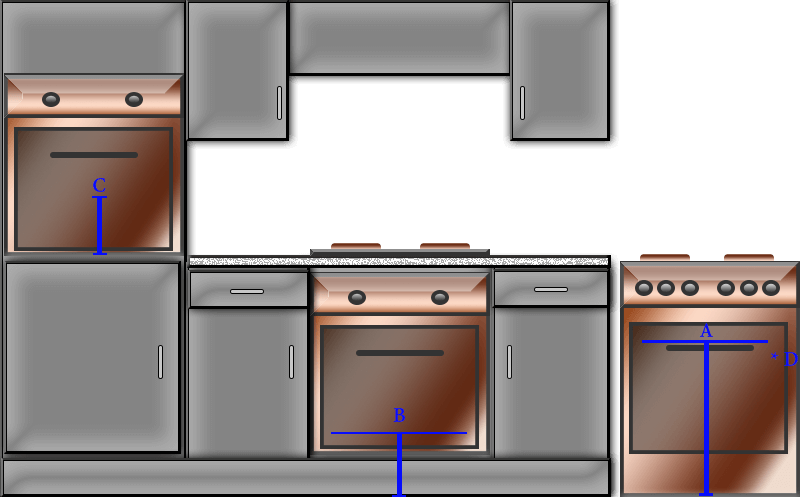
Cooking Appliance Installation & Repair Specialists.

This is split into 2 sections, Electric & Gas

IN GENERAL
There are 2 methods used to connect gas appliances to the household supply.
The first uses a rigid connection, typically used to connect gas hobs.
The second uses a flexible hose, which is used for all other appliances except the hob.
In addition every gas appliance installation requires a method to isolate the appliance from the main household gas supply
HOBS
Gas hobs are typically connected to the household supply using 15mm rigid copper pipe. They must have a means of isolation so you can turn the gas supply off to the hob. This is achieved by adding a shut off tap to the installation pipework as close to the hob as it possible. There must also be a means of disconnecting the pipework from the hob. This is normally achieved by using a compression joint.
TYPICAL INSTALLATION FAULTS
No isolation tap. Insecure pipeworkFREE STANDING COOKERS - RANGES - BUILT IN OVENS
These appliances are normally connected to the household supply using a specifically designed flexible hose that connects to a self sealing bayonet fitting.
The bayonet fitting also serves as the isolation device.
The siting of the bayonet fitting and the way in which the flexible hose hangs are covered in detail by gas regulations and must be adhered to.
Briefly the flexible hose must hang in a "U" shape, (as illustrated in the image below), behind the appliance without touching the floor.
It must not foul on any edges or potentially be trapped or be strained when removing the appliance.
This is covered in more detail further down the page

TYPICAL INSTALLATION FAULTS
Bayonet location incorrect. (Too low or in an adjacent cupboard) Bayonet facing upwards Bayonet & or pipwork insecure Flexible hose location and routing incorrectCORRECT LOCATION OF BAYONET

IMPORTANT Manufacturers instructions take precedence over the following standards
CONNECTIONSMUST
FLEXIBLE HOSE
- Hang freely vertically creating a "U" shape
- Allow the appliance to be removed while connected without being strained or stressed
BAYONET
- Be located behind the appliance
- Be secured to the wall (Fabrication of the building)
- Be pointing down UNLESS the flexible hose has a right angled connector, then it can point sideways
RIGID
- Have a gas rated isolation tap
- Have a means of disconnection (e.g. compression joint)
DIMENSIONS
BAYONET LOCATION
- A : 750mm Above finished floor level
- B : 50-75mm Above finished floor level
- C : See manufacturers instructions
PREVIOUS STANDARD
BAYONET LOCATION
Still in use by many manufacturers
- D :
- 500-600mm Above finished floor level
- 50-100mm Inside the edge from the right side of the appliance
CONNECTIONSMUST NOT
FLEXIBLE HOSE
- Foul or be trapped on cupboard edges
- Touch hot surfaces
BAYONET
- Point Up
- Be fitted into adjacent cupboards
- Be secured to the cupboards
RIGID
- Pipework Not foul on
- Built in oven installed below it
- Cupboard drawers

IN GENERAL
There are 2 types of connection One that plugs into a typical plug socket (Or a fused spur equivalent) One that requires a 'Cooker point' The simplest way to explain the 2 methods, is that the more elements you can have on at any one time, the higher the fuse rating and thickness of cable you will require. For example, a double electric oven (2 doors) can have the oven and the grill on at the same time. This would take out a 13 amp fuse, which is the highest fuse rating you can have in a plug socket. So we need a method that allows a higher fuse rating connection. This is accomplished by using a cooker point which is normally protected by a 32 amp fuse
PLUG SOCKET CONNECTION
Basic guideline. If the appliance comes with a cable connected to it, then the maximum rating will be 13 amps This means it uses a normal plug socket or what is called a fused spur, which can take up to a 13 amp fuse. In most (but not all cases) they will already have a plug attached to the cable Appliances that use this type of connection are: Built in Gas Hobs Built in Gas Ovens Built in Single Electric Ovens (Having 1 door) Gas Ranges.TYPICAL INSTALLATION FAULTS
Cooker wired up to cooker point instead of a plug socket/fused spurCOOKER POINT CONNECTION
If the appliance does not come with a cable attached to it then it will most likely require connection to a cooker point. This will require 4-6mm cooker flex that does not come with the appliance. Appliances that will use this type of connection are:
Built in electric hobs
Built in Electric Double ovens, (Having 2 doors)
Electric free standing cookers & Ranges.
Dual Fuel free standing cookers & Ranges.
Appliances that will use this type of connection are:
Built in electric hobs
Built in Electric Double ovens, (Having 2 doors)
Electric free standing cookers & Ranges.
Dual Fuel free standing cookers & Ranges.

